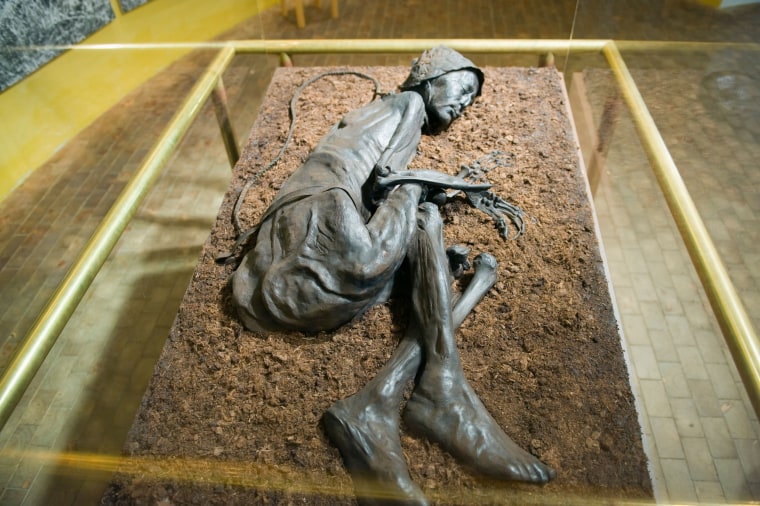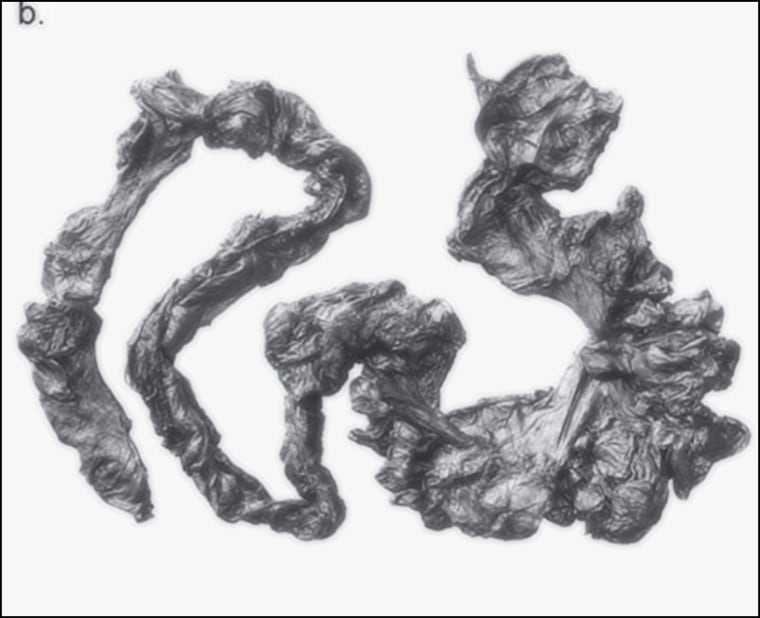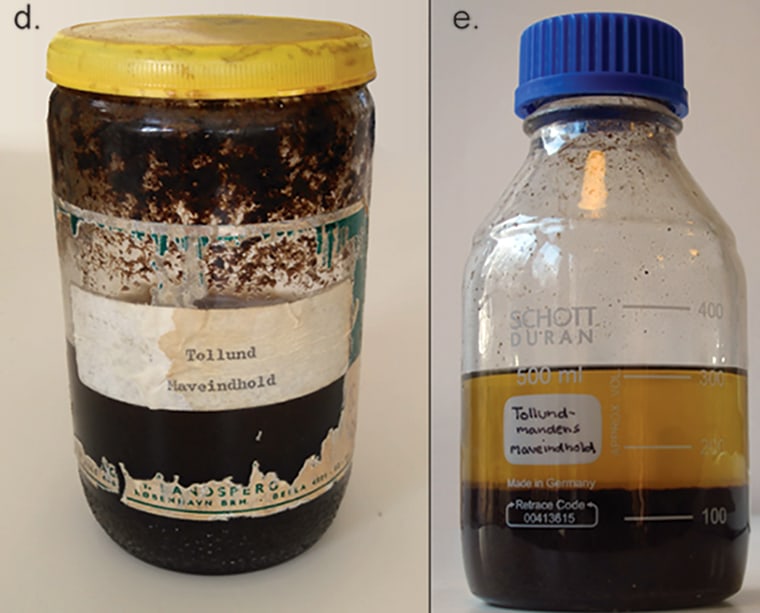A study of the gut of a well-preserved body from a bog in Denmark has offered new details that researchers say hint at dark rituals.

Preserved body of the Tollund Man on display at the Silkeborg Museum, Silkeborg, Denmark.Robert Harding / Alamy Stock Photo
July 21, 2021
By Tom Metcalfe
When the Tollund Man was discovered in a bog in Denmark 71 years ago, he was so well preserved that his finders thought he was the victim of a recent murder.
It took archaeologists to reveal he had been thrown into the bog almost 2,400 years ago, and that he’d first been hanged — a noose of plaited animal hide was still around his neck. The careful arrangement of the body and face — his closed eyes and faint smile — suggested he may have been killed as a human sacrifice, rather than executed as a criminal.
The suggestion that the Tollund Man was killed as a human sacrifice has now been reinforced by a study of the condemned man’s frugal last meal, made from a detailed investigation of the contents of his digestive tract: A porridge of barley, flax and pale persicaria.
The seeds of pale persicaria are the clue to this Iron Age murder mystery, said archaeologist Nina Nielsen, the head of research at Denmark’s Silkeborg Museum and the lead author of the study published Tuesday.

July 21, 2021
By Tom Metcalfe
When the Tollund Man was discovered in a bog in Denmark 71 years ago, he was so well preserved that his finders thought he was the victim of a recent murder.
It took archaeologists to reveal he had been thrown into the bog almost 2,400 years ago, and that he’d first been hanged — a noose of plaited animal hide was still around his neck. The careful arrangement of the body and face — his closed eyes and faint smile — suggested he may have been killed as a human sacrifice, rather than executed as a criminal.
The suggestion that the Tollund Man was killed as a human sacrifice has now been reinforced by a study of the condemned man’s frugal last meal, made from a detailed investigation of the contents of his digestive tract: A porridge of barley, flax and pale persicaria.
The seeds of pale persicaria are the clue to this Iron Age murder mystery, said archaeologist Nina Nielsen, the head of research at Denmark’s Silkeborg Museum and the lead author of the study published Tuesday.

Tollund Man’s large intestine.Danish National Museum
The plant grows wild among barley crops, but evidence from Iron Age grain storage shows it was usually cleaned out as a weed during threshing. That suggests it was part of “threshing waste” that was added to the porridge deliberately — perhaps as part of a ritual meal for those condemned to die by human sacrifice.
“Was it just an ordinary meal? Or was threshing waste something you only included when people were eating a ritual meal?” Nielsen said. “We don’t know that.”
The contents of the Tollund Man’s preserved intestines were examined soon after he was found. But the new study refines that initial examination with much improved archaeological techniques and instruments.
“Back in 1950, they only looked at the well preserved grains and seeds, and not the very fine fraction of the material,” Nielsen said. “But now we have better microscopes, better ways of analyzing the material and new techniques. So that means that we could get more information out of it.”
As well as revealing the clue of the threshing waste added to his last meal, the researchers found it was probably cooked in a clay pot — pieces of overcooked crust can be seen in the traces — and that he’d also eaten fish. They also found he was suffering from several parasitic infections when he died, including tapeworms — probably from a regular diet of undercooked meat and contaminated water, Nielsen said.

The plant grows wild among barley crops, but evidence from Iron Age grain storage shows it was usually cleaned out as a weed during threshing. That suggests it was part of “threshing waste” that was added to the porridge deliberately — perhaps as part of a ritual meal for those condemned to die by human sacrifice.
“Was it just an ordinary meal? Or was threshing waste something you only included when people were eating a ritual meal?” Nielsen said. “We don’t know that.”
The contents of the Tollund Man’s preserved intestines were examined soon after he was found. But the new study refines that initial examination with much improved archaeological techniques and instruments.
“Back in 1950, they only looked at the well preserved grains and seeds, and not the very fine fraction of the material,” Nielsen said. “But now we have better microscopes, better ways of analyzing the material and new techniques. So that means that we could get more information out of it.”
As well as revealing the clue of the threshing waste added to his last meal, the researchers found it was probably cooked in a clay pot — pieces of overcooked crust can be seen in the traces — and that he’d also eaten fish. They also found he was suffering from several parasitic infections when he died, including tapeworms — probably from a regular diet of undercooked meat and contaminated water, Nielsen said.

Tollund Man’s intestine content.N.H. Nielsen
The Tollund Man is one of dozens of bog bodies from the Iron Age between about 2,500 and 1,500 years ago that have been found throughout Northern Europe. They were mummified in the bogs by the low oxygen levels, low temperatures and water turned acidic by the layers of decaying vegetation, or peat, that are found there.
A few seem to have been the victims of accidents, possibly people who drowned after falling into the water. But most, like the Tollund Man, were killed and placed in the bogs deliberately, with their bodies and features carefully arranged. Archaeologists think they were selected as human sacrifices, possibly to avert a pending disaster like a famine.
Miranda Aldhouse-Green, a professor emeritus of history, archaeology and religion at Cardiff University in the United Kingdom and the author of the book “Bog Bodies Uncovered: Solving Europe’s Ancient Mystery,” said the seeds of pale persicaria and other traces of threshing waste in the Tollund Man’s last porridge are further evidence that he was sacrificed.
“That reinforces the idea that he either was being shamed by being given something disgusting and horrible to eat, or it actually reflected the fact that society was in a downward spiral where food was scarce,” she said.
The idea that the human sacrifice victims had somehow been “shamed” before death was also reflected in their burials in bogs, instead of the usual burials in tombs and dry graves, she said.
The preservational properties of bogs were well known to people in the Iron Age — many archaeological objects from that time, including pieces of expensive pottery, were also deliberately deposited there — and it could be that the preservation of a bog body was intended to keep it from joining its ancestors. Bogs were seen as gateways to another realm.
“If you put a body in the bog, it would not decay — it would stay between the worlds of the living and the dead,” Aldhouse-Green said.

The Tollund Man is one of dozens of bog bodies from the Iron Age between about 2,500 and 1,500 years ago that have been found throughout Northern Europe. They were mummified in the bogs by the low oxygen levels, low temperatures and water turned acidic by the layers of decaying vegetation, or peat, that are found there.
A few seem to have been the victims of accidents, possibly people who drowned after falling into the water. But most, like the Tollund Man, were killed and placed in the bogs deliberately, with their bodies and features carefully arranged. Archaeologists think they were selected as human sacrifices, possibly to avert a pending disaster like a famine.
Miranda Aldhouse-Green, a professor emeritus of history, archaeology and religion at Cardiff University in the United Kingdom and the author of the book “Bog Bodies Uncovered: Solving Europe’s Ancient Mystery,” said the seeds of pale persicaria and other traces of threshing waste in the Tollund Man’s last porridge are further evidence that he was sacrificed.
“That reinforces the idea that he either was being shamed by being given something disgusting and horrible to eat, or it actually reflected the fact that society was in a downward spiral where food was scarce,” she said.
The idea that the human sacrifice victims had somehow been “shamed” before death was also reflected in their burials in bogs, instead of the usual burials in tombs and dry graves, she said.
The preservational properties of bogs were well known to people in the Iron Age — many archaeological objects from that time, including pieces of expensive pottery, were also deliberately deposited there — and it could be that the preservation of a bog body was intended to keep it from joining its ancestors. Bogs were seen as gateways to another realm.
“If you put a body in the bog, it would not decay — it would stay between the worlds of the living and the dead,” Aldhouse-Green said.

The ingredients of Tollund Man’s last meal, in relative quantities: A) barley seeds; B) pale persicaria; C) barley fragments; D) flax; E) black-bindweed; F) "fat hen" seeds; G) sand; H) hemp-nettles; I) camelina; J) corn spurrey; K) field pansy. P.S. Henriksen / Danish National Museum
There’s evidence that threshing waste was added to the last meal of another Iron Age bog body found in Denmark in 1952, that of the Grauballe Man, who is also thought to have been killed as a human sacrifice. Although more than 100 bog bodies have now been found, only 12 are preserved well enough that their last meals can be analyzed, Nielsen said, and she hopes now to look for further evidence of the ritual practice.
The Tollund Man now occupies a glass case in a special gallery at the Silkeborg Museum, where Nielsen can see him almost every day.
“You’re standing face to face with a person from the past,” she said. “He’s 2,400 years old — that’s really amazing.”
There’s evidence that threshing waste was added to the last meal of another Iron Age bog body found in Denmark in 1952, that of the Grauballe Man, who is also thought to have been killed as a human sacrifice. Although more than 100 bog bodies have now been found, only 12 are preserved well enough that their last meals can be analyzed, Nielsen said, and she hopes now to look for further evidence of the ritual practice.
The Tollund Man now occupies a glass case in a special gallery at the Silkeborg Museum, where Nielsen can see him almost every day.
“You’re standing face to face with a person from the past,” she said. “He’s 2,400 years old — that’s really amazing.”













